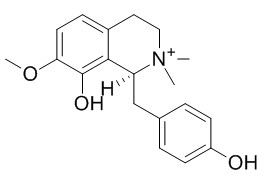Oblongine
Oblongine chloride may have potential haemodynamic effects, it can cause a dose-dependent reduction of systolic and diastolic blood pressure, and that these effects are not mediated by β-adrenergic receptor stimulation.
Inquire / Order:
manager@chemfaces.com
Technical Inquiries:
service@chemfaces.com
Tel:
+86-27-84237783
Fax:
+86-27-84254680
Address:
1 Building, No. 83, CheCheng Rd., Wuhan Economic and Technological Development Zone, Wuhan, Hubei 430056, PRC
Providing storage is as stated on the product vial and the vial is kept tightly sealed, the product can be stored for up to
24 months(2-8C).
Wherever possible, you should prepare and use solutions on the same day. However, if you need to make up stock solutions in advance, we recommend that you store the solution as aliquots in tightly sealed vials at -20C. Generally, these will be useable for up to two weeks. Before use, and prior to opening the vial we recommend that you allow your product to equilibrate to room temperature for at least 1 hour.
Need more advice on solubility, usage and handling? Please email to: service@chemfaces.com
The packaging of the product may have turned upside down during transportation, resulting in the natural compounds adhering to the neck or cap of the vial. take the vial out of its packaging and gently shake to let the compounds fall to the bottom of the vial. for liquid products, centrifuge at 200-500 RPM to gather the liquid at the bottom of the vial. try to avoid loss or contamination during handling.
Pharmaceuticals (Basel).2024, 17(10):1368.
Int J Mol Sci.2022, 23(21):13112.
Asian Journal of Chemistry2018, 30(12):2699-2703
Chemistry of Plant Raw Materials2019, 4:135-147
Int J Vet Sci Med.2024, 12(1):134-147.
Front Pharmacol.2025, 16:1611342.
J AOAC Int.2021, 104(6):1634-1651.
Planta Med.2019, 85(4):347-355
Antioxidants (Basel).2024, 13(12):1530.
Heliyon.2023, 9(12):e22932.
Related and Featured Products
Gen Pharmacol. 1993 Mar;24(2):299-304.
Effects of oblongine chloride, an alkaloid from Leontice leontopetalum on guinea-pig isolated smooth muscle and heart.[Pubmed:
8482513]
1. The effects of (-)Oblongine chloride, a quaternary alkaloid from Leontice leontopetalum, on guinea-pig isolated ileal longitudinal segments, main pulmonary artery rings, spontaneously-beating atrium and isolated perfused heart were studied.
METHODS AND RESULTS:
2. Oblongine chloride (3 x 10(-5)-10(-3) M) caused concentration-dependent relaxation of ileum, an effect which was not blocked by propranolol (10(-6) M) alone or in combination with prazosin (3 x 10(-8) M), or by indomethacin (10(-6) M), but was reduced by desensitization of the preparation by prior exposure to 3 x 10(-5) M ATP and, at high concentrations of Oblongine, by a combination of propranolol and yohimbine (3 x 10(-6) M). 3. Oblongine chloride (10(-5)-3 x 10(-3) M) caused concentration-dependent relaxation of epinephrine-precontracted pulmonary artery. This effect was not affected by propranolol or by indomethacin but was significantly attenuated by pretreatment with 3 x 10(-5) M ATP and potentiated by pretreatment with quinacrine (10(-5) M). 4. Oblongine chloride (10(-5) M-3 x 10(-3) M) caused concentration-dependent increase in the contractility but did not affect the rate of the atrium. Similar effects were obtained with isolated perfused heart except that large concentrations of Oblongine (10(-3), 3 x 10(-3) M) inhibited both contractility and rate of the heart.
CONCLUSIONS:
The inotropic effects of Oblongine on the atrium were not blocked by propranolol or indomethacin but were significantly blocked by quinacrine.
Phytother. Res., 1995, 9(1):60-3.
Cardiovascular effects of oblongine chloride, an alkaloid from Leontice leontopetalum, in the anaesthetized guinea-pig[Reference:
WebLink]
The effects of (61)Oblongine chloride, a quaternary alkaloid from Leontice leontopetalum on blood pressure, heart rate and blood flow of the anaesthetized guinea-pig were studied.
METHODS AND RESULTS:
At doses ranging from 0.5 mg/kg to 30 mg/kg, i.v., Oblongine chloride caused a dose-dependent reduction of systolic and diastolic blood pressure. These doses were associated with an increase in heart rate. Propranolol (5 mg/kg) failed to block the effects of Oblongine chloride on systolic and diastolic blood pressure but significantly reduced the increase in heart rate observed with low doses (0.5–6 mg/kg) of Oblongine chloride. In doses ranging from 0.05 mg/kg to 0.5 mg/kg, Oblongine chloride caused a small increase in blood flow. Larger doses (1.5, 4.5, 15 and 30 mg/kg) caused an initial decrease followed by an increase of blood flow. The net effect of cumulative doses was an increase in blood flow over the control value.
CONCLUSIONS:
These observations suggest that Oblongine chloride may have potential haemodynamic effects and that these effects are not mediated by β-adrenergic receptor stimulation.



